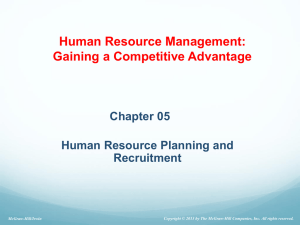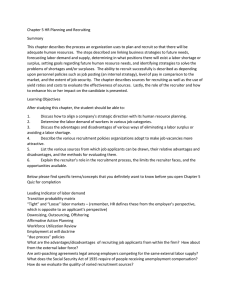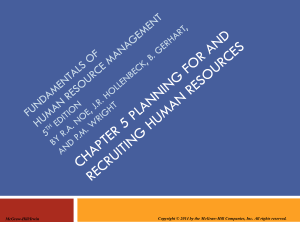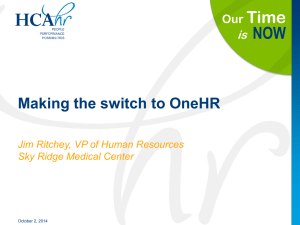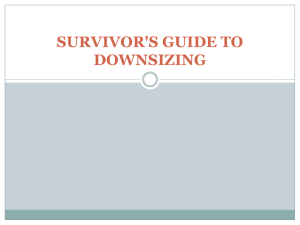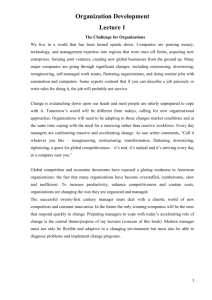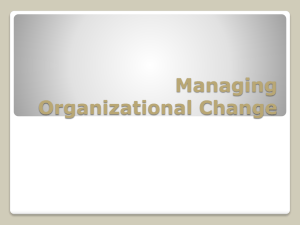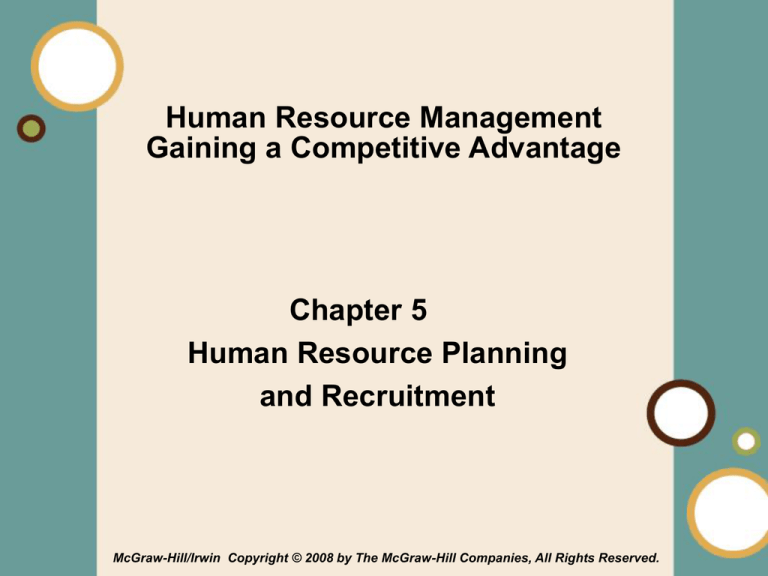
Human Resource Management
Gaining a Competitive Advantage
Chapter 5
Human Resource Planning
and Recruitment
McGraw-Hill/Irwin Copyright © 2008 by The McGraw-Hill Companies, All Rights Reserved.
1-1
Learning Objectives
After reading this chapter, you should be able to:
• Discuss how to align a company’s strategic direction with
its human resource planning.
• Determine the labor demand for workers in various job
categories.
• Discuss the advantages and disadvantages of various
ways of eliminating a labor surplus and avoiding a labor
shortage.
• Describe the various recruitment policies that
organizations adopt to make job vacancies more
attractive.
• List the various sources from which job applicants can be
drawn, their relative advantages and disadvantages, and
the methods for evaluating them.
• Explain the recruiter’s role in the recruitment process, the
limits the recruiter faces, and the opportunities available.
5-2
Stages in Human Resource
Planning
• Forecasting
• Goal Setting and Strategic
Planning
• Program Implementation
and Evaluation
5-3
Forecasting Stage of Human
Resource Planning
• Determining Labor Demand
– derived from product/service demanded
– external in nature
• Determining Labor Supply
– internal movements caused by transfers,
promotions, turnover, retirements, etc.
– transitional matrices identify employee
movements over time
– useful for AA / EEO purposes
• Determining Labor Surplus or Shortage
5-4
Strategies for Reducing an
Expected Labor Surplus
Option
1.
2.
3.
4.
5.
6.
7.
8.
9.
Downsizing
Pay reductions
Demotions
Transfers
Work sharing
Hiring freeze
Natural attrition
Early retirement
Retraining
Speed
Fast
Fast
Fast
Fast
Fast
Slow
Slow
Slow
Slow
Extent of Human Suffering
High
High
High
Moderate
Moderate
Low
Low
Low
Low
5-5
Strategies for Reducing an
Expected Labor Surplus
Option
1. Overtime
2. Temporary
employees
3. Outsourcing
4. Retrained transfers
5. Turnover reductions
6. New external hires
7. Technological
innovation
Speed
Extent of Human Suffering
Fast
Fast
High
High
Fast
Slow
Slow
Slow
Slow
High
High
Moderate
Low
Low
5-6
Downsizing
• Downsizing is the planned elimination of
large numbers of personnel designed to
enhance organizational competitiveness.
• Reasons for downsizing include:
– need to reduce labor costs
– technological changes reduce need for labor
– mergers and acquisitions reduce bureaucratic
overhead
– organizations choose to change the location
of where they do business
5-7
Effects of Downsizing
• Studies show that firms that announce a
downsizing campaign show worse, rather
than better financial performance.
• Reasons include:
– The long-term effects of an improperly
managed downsizing effort can be negative.
– Many downsizing campaigns let go of people
who turn out to be irreplaceable assets.
– Employees who survive the staff purges often
become narrow-minded, self-absorbed, and
risk-averse.
5-8
Early Retirement Programs
• The average age of the U.S. workforce is
increasing.
• Baby boomers are not retiring early for several
reasons:
– improved health of older people
– a fear that Social Security will be cut
– mandatory retirement is outlawed
• Many employers try to induce
voluntary attrition among older
workers through early
retirement incentive programs.
5-9
Employing Temporary Workers
• Hiring temporary workers helps eliminate a labor
shortage.
• Temporary employment affords firms the
flexibility needed to operate efficiently in the face
of swings in demand.
• Other advantages include:
– temporary workers free a firm from many
administrative tasks and financial burdens
– temporary workers are often times tested by a
temporary agency
– many temporary agencies train employees before
sending them to employees
5-10
Outsourcing and Offshoring
• Outsourcing is an organization’s use of an
outside organization for a broad set of services.
• Offshoring is a special case of outsourcing
where the jobs that move actually leave one
country and go to another.
• To help ensure the success of outsourcing:
– Choose an outsourcing vendor that is large and
established.
– Jobs that are proprietary or require tight security should
not be outsourced.
– It is a good idea to start small and monitor constantly.
5-11
Affirmative Action Planning
• It is important to plan for various subgroups
within a labor force.
• A comparison of the proportion of workers in
protected subgroups with the proportion that
each subgroup represents is called a workforce
utilization review.
• The steps required to execute an affirmative
action plan are identical to the steps in the
generic planning process discussed earlier.
5-12
The Human Resource
Recruitment Process
Job Choice
Vacancy
Characteristics
Personnel
Policies
Job
Choice
Recruiter Traits
and Behaviors
Applicant
Characteristics
Recruitment
Sources
Recruitment Influences
5-13
Personnel Policies
• Characteristics of the vacancy are more
important than recruiters or recruiting
sources.
• Personnel Policies vary:
– Internal versus External recruiting
– Extrinsic versus Intrinsic rewards
– Employment-at-will policies
– Image advertising
5-14
Recruitment Sources
Colleges and Universities Internal Sources -
campus placement services
Public & Private
Employment Agencies -
Faster, cheaper,
more certainty
External Sources New ideas and
approaches
headhunters, can be
expensive
JOBS
JOBS
Electronic Recruiting the Internet
Direct Applicants
and Referrals self selection,
low cost
Newspaper Advertising large volume, low
quality recruits
5-15
Recruiters
• Functional Area
– HR- versus operating
area-specialist
• Traits
– warm and informative
• Realism
– realistic job preview,
honesty
5-16
Steps to Enhance Recruiter
Impact
1. Provide timely feedback
1. Provide timely feedback
2. Avoid rude behavior
2. Avoid rude behavior
3. 3.
Recruit
Recruitin
in teams
teams
5-17

